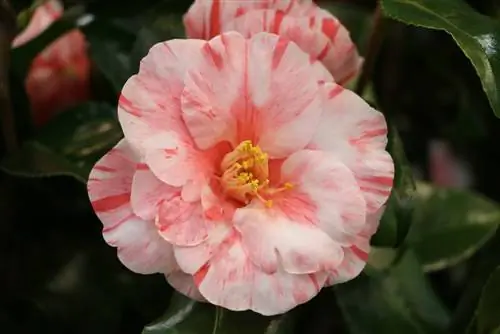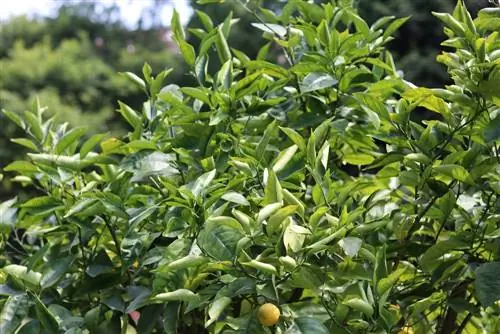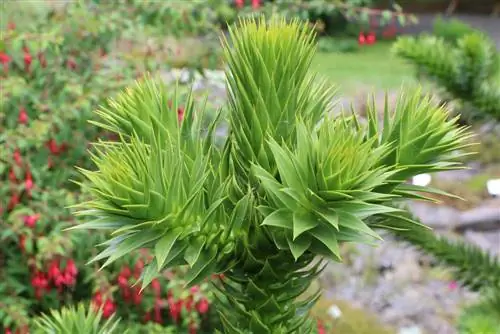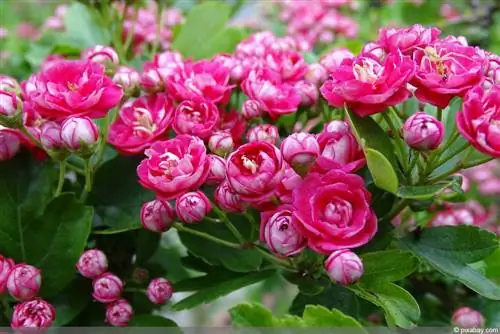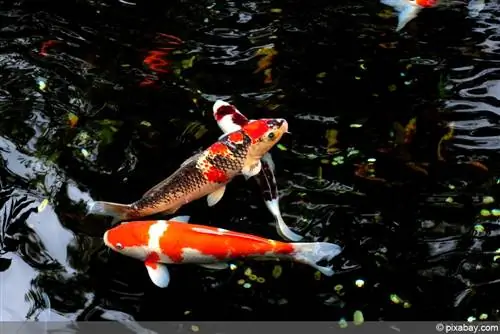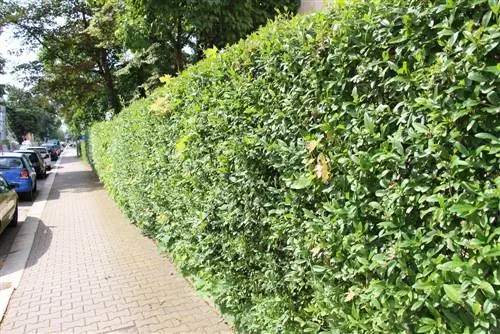- Author admin [email protected].
- Public 2023-12-17 03:39.
- Last modified 2025-06-01 06:48.
The flower color can vary slightly depending on the type of soil and light intensity and is therefore not a reliable guide for classification. Since the varieties vary only slightly in color, even the best photos are often misleading.
The flowering time also varies depending on the climate and location. It is delayed by a harsh winter and, conversely, sets in prematurely after a long, hot summer. Nevertheless, a rough distinction can be made between early, normal and late blooming camellias. The former bloom from late autumn to mid-winter, those of the second group from mid-winter to early spring and the latter from early to late spring.
Flower size is an important criterion for classification. A distinction is made between the following categories:
- very large: about 12.5cm;
- large: 10 to 12.5 cm
- medium: 7.5 to 10 cm, sometimes differentiated between medium-sized (9 - 10 cm) and medium-sized flowers (7.5 to 9 cm)
- small: 5 to 7.5 cm, there are occasional overlaps with a miniature group (flower size less than 6.5 cm)
Subdivision
Flowers have a ring of a maximum of eight petals and clearly visible stamens.
- Semi-double flowers show two or more rings around a tuft of prominent stamens
- Anemone-flowered forms can be recognized by one or more outer rings of flat or slightly wavy petals and in the middle a mass of fused petals and stamens.
- Peony-flowered forms are deeply rounded; They consist of numerous loose to irregular outer petals, petaloids and stamens.
- Rose-shaped filled forms have overlapping petals that form a rounded head and, when opened, reveal a concave center with a few stamens.
- Fully double ones resemble the rose-petaled forms, but their symmetrically overlapping petals never open; They also have no stamens, so they are sterile.
The right choice
C.-japonica - forms can only overwinter outside in very mild regions. They also bloom very early, so their flowers are easily damaged by frost. As a rule, it is best to grow them in Germany in an unheated greenhouse or winter garden. They grow bushy and reach a height of 1.8 - 3.6 m.
The wild form of C.reticulata only survives outdoors in very mild climates, but not in Germany. It is characterized by a more open growth habit than other camellias. The cultivated forms of this species only thrive in greenhouses. Under ideal conditions they grow to 3 - 4.5 m high and bloom from late winter to mid-spring.
The C. x williamsiee hybrids that bloom from late autumn to mid-spring and when they are young are most suitable for our latitudes. They develop well in woody plantings or in front of a wall. The plants grow to a height of 1.8 - 2.4 m and therefore fit into small gardens even when they are older.
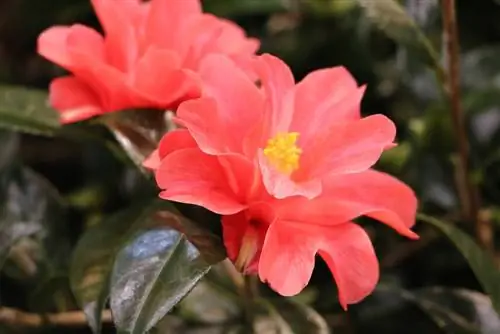
C.sasanqua and the cultural forms that have emerged from it are of extraordinary beauty. However, their suitability is almost exclusively limited to greenhouses and winter gardens. The flowers are small and mostly unfilled.
Planting outdoors
In mild regions, camellias are planted outdoors in early to late autumn or early to mid-spring when the weather is good. They require well-drained, lime-free, acidic to neutral soil, enriched with leaf compost if possible. If rhododendrons thrive in your garden, camellias will too. A western or sheltered northern location is ideal. Otherwise, we recommend a place in front of a wall or under trees where the plants are protected from frost and early morning sun. Light shade with full sun at a later hour is optimal.
The plants are planted flat (no deeper than they were in the nursery) and firmly in the ground and mulched with peat or leaf compost. Never plant camellias in an east-facing location where heavy frost is followed by bright morning sun. This would cause the buds to thaw too quickly and show brown edges after they bloom. Southern exposure is also not suitable, as camellias like to be rooted in cool soil.
A sheltered garden not only ensures that the temperature rises slowly, but also shields the plants from strong winds that could damage the tender buds. If the location is unavoidably exposed to wind, support young plants until they have settled in and set up a windbreak.
Plant in pots
Especially early-flowering camellias are best grown in 20 - 30 cm pots or small planters. The substrate consists of four parts lime-free clay, two parts leaf compost or peat and one part coarse sand. It is enriched with 1 handful of bone meal/bucket. Alternatively, use a commercially available potting soil specifically for acid-loving plants.
Place the pot or bucket outside in a protected, partially shaded place from the end of spring to mid-autumn. Then move it to a cool greenhouse or winter garden, where the plant will overwinter at 4 - 7 degrees Celsius until the end of spring. To speed up flower formation, increase the temperature to 9 - 12 degrees Celsius. You can also plant the camellias directly in a greenhouse bed and grow them under glass all year round.
Care
Once established, camellias require little regular care. You don't have to cut them back, just shorten shaggy shoots in mid-spring after flowering to maintain their shape. Particularly large flowers can be achieved by thinning the buds before they open.
Every year in mid-spring, camellias are mulched generously - an approximately 5 cm thick layer over the entire root area is ideal - made of leaf compost, peat or well-rotted manure.
After flowering, the wilted flower heads are removed. This is mainly done for aesthetic reasons. This also prevents the formation of fruit. They are not particularly decorative and deprive the plant of strength.
Propagate camellias
Take 7.5 - 10 cm long cuttings from half-ripened side shoots during the summer months. Let them root in a mixture of peat and sand in equal proportions or in potting soil. The best results are achieved at a substrate temperature of 13 - 16 degrees Celsius.
Varieties that do not root well, such as C. reticulata forms, are best propagated by lowering branches of larger plants in early autumn. As a rule, these months later are sufficiently rooted and can then be removed and planted in place.
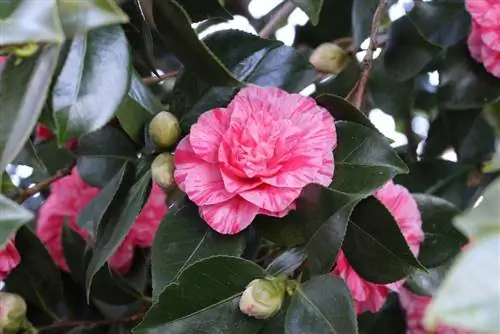
If you want to get lots of young plants, take leaf cuttings in summer. Rooting takes place in pots or bowls, as already described for sprout cuttings.
Pests and diseases
The only pests that are truly dangerous for camellias are birds that pick out the buds. Further problems can be caused by frost damage and bud drop due to soil that is too dry.
Physiological disorders include browning of the leaves caused by nighttime cold and dull green foliage with brown and black spots surrounded by slight bumps. Such symptoms often occur in plants grown in alkaline soil.
If camellias are grown under glass, aphids and scale insects may appear on leaves and buds.
The camellia is a tea plant and a plant for connoisseurs, that is, for gardeners with empathy and a sense of something special. The camellia is very demanding and reacts extremely sensitively to changes. If you want to deal with the camellia, you need a lot of specialist knowledge and should inform yourself in detail, as it can happen very quickly that the camellia dies.
What you need to know about care
There are many things to consider when planting in the garden. The soil must be acidic with an optimal pH value of 4-5.5, as well as containing humus, clay and sand. Under no circumstances should the camellia be planted in calcareous soil. It must be kept evenly moist, but waterlogging must be avoided at all costs. This can be achieved, for example, with gravel drainage. Camellias should only be planted if they are older than three years; it would be better if they are already four-year-old plants. It should be protected from easterly winds, but it should definitely get afternoon sun, as this promotes flower formation. Under no circumstances should they be exposed to direct sunlight or morning sun. Favorable locations are, for example, in the protection of hedges or under sparse trees that have deep roots. A western location in the shade of a house is also recommended. The camellia needs high humidity, especially on hot days, but it should be protected against constant rain with covers. The camellia can tolerate temperatures down to -10 degrees Celsius for short periods of time as long as the soil is moist even in winter. Most importantly, the roots never dry out. During the growth of the plant until the buds form, it should be watered with lukewarm, lime-free water and additionally sprayed. Camellias are also sensitive to fertilizer s alts; they should only be given nutrients approximately 14 days from the start of flowering until the end of July. The soil is best mulched all year round.
As soon as new leaves and buds become visible, a rest phase of 4 -6 weeks begins. During the dormant phase, water less and only spray every now and then. However, you must not allow the root ball to dry out even during the rest period. The best planting time is spring, the temperature range depends on the variety.
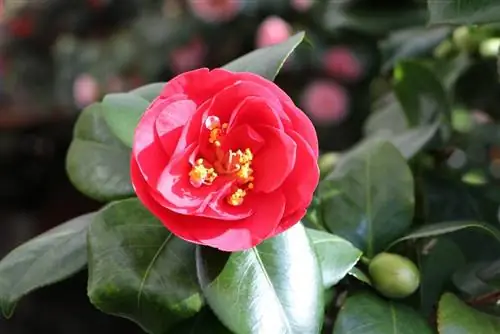
Keeping a camellia indoors is, as I said, a little more complicated. She needs a bright and cool place, which she always has if possible. The planter must also not be rotated because the camellia could then react by dropping its buds. A cool winter garden with a temperature range of 5 - 10 degrees Celsius is best. The camellia also needs to be protected from the blazing summer sun; it can withstand the winter sun a little better. The soil in the planter should be loose, humus-rich and acidic. Here too, waterlogging should never occur, so drainage in the lower area is advisable. Regular ventilation and moist air are just as important as watering with lime-free water. The best solution is to use rainwater. When kept indoors, fertilization is also required for 14 days, ideally with special camellia fertilizer, and a six-week rest period from August to September. In all seasons the plant must not be rotated; instead, the back branches can be exposed to the sun using mirrors or aluminum foil. Alternative locations for the winter garden would also be a bright but cool staircase or a veranda where the conditions are right.
If you as a gardener meet all the requirements and needs of the plant that comes from East Asia, then you will be rewarded with beautiful blood-red, pink, white, spotted, double or semi-double, light red or yellow flowers, depending on the species. Depending on the species, the camellias bloom between December and April.

